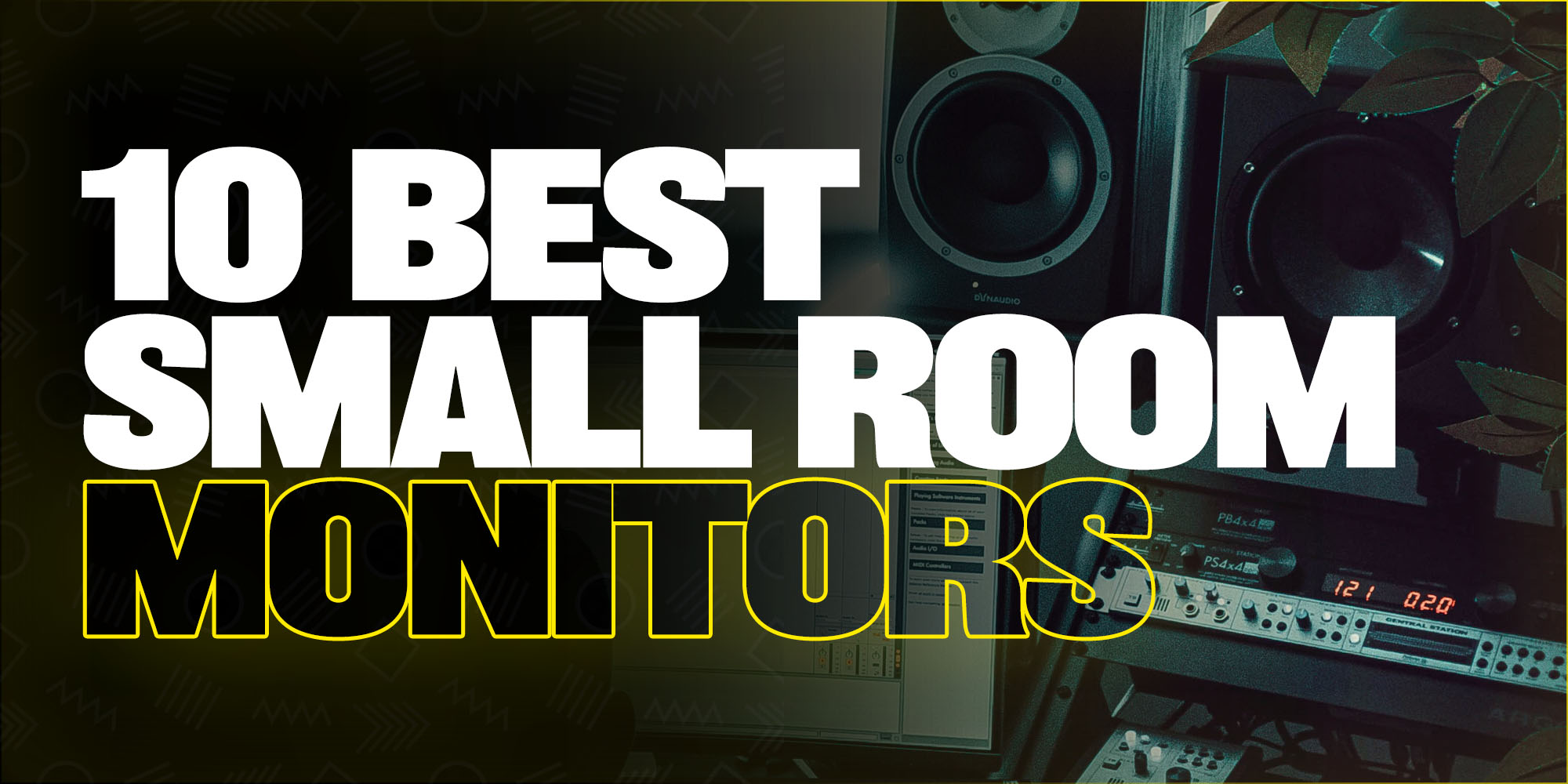
How to Find The Right Small Studio Monitor For You
When shopping around for studio monitors, there are a lot of variables you need to be aware of.
This can sometimes be overwhelming.
Which monitors are the best?
There are usually no best studio monitors for all situations, but every speaker will be the best for any unique given situation.
Knowing what size studio monitors to get for a small room can be daunting.
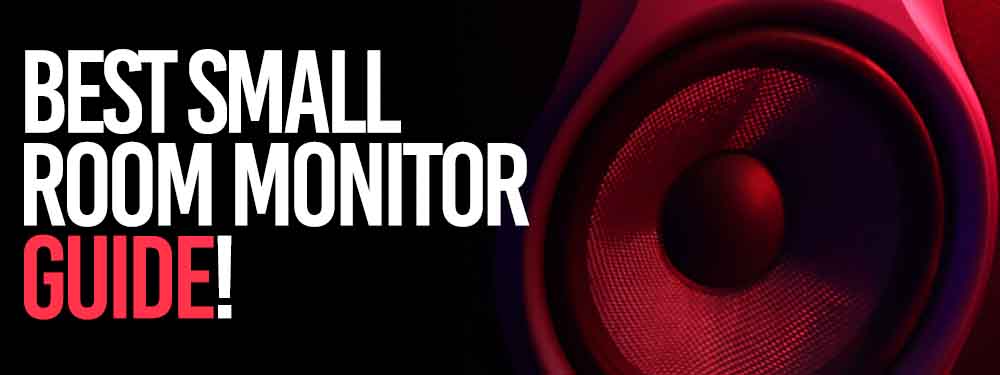
But the bright news is that you can find good studio monitors that provide a surprisingly good bass response and mid-frequency sounds for even a very limited space!
Below we'll dive into the best studio monitor speakers and portable studio monitors.
I'll rank them to help you determine which will work best for your studio space.
10 Best Studio Monitors For a Small Room or Home Studio
These are the best studio monitors for a small room, taking into account bass response, bass frequencies, build quality, and other factors for a small space:
Top 10 Studio Monitors for small rooms:
Let's dive into the list right now:
#10. PreSonus Eris E3.5 – 3.5″
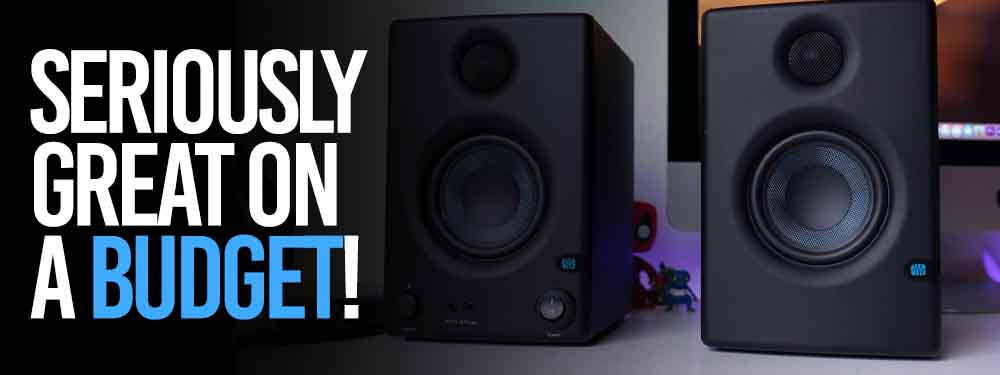
The PreSonus Eris 3.5-inch Monitor is one of the top brands out there and it's well worth a second look at, with many reviews speaking to its quality.
It offers a clear sound for studio uses like mixing and mastering music.
This monitor has RF interference protection as well as noise isolation; plus Turn-On/Off transient protection so you can focus on your work without interruption!
Included are performance specs that would be perfect for any studio:
Acoustic tuning allows you to get pristine sound within small rooms while the crossover frequency is 2.8 kHz - making this an excellent choice if your room size doesn't allow for larger monitors just yet still delivers fantastic audio results!
Unfortunately, the E35 doesn’t have any height adjustment, but it’s still fairly compact, so it won’t take up too much space on your desk.
The E35 has a frequency response of 45 Hz – 20 kHz, a 3-inch driver, and a neodymium magnet. It also has a single-cable connection, which makes it very convenient to set up.
PreSonus’s E35 offers professional sound quality, thanks to its active design.
It also has an impressive max SPL, so you can use it in loud environments without worrying about blowing out your ears.
The E35 is an affordable option and a great choice for beginners. It’s also compact and easy to set up, and it has a single-cable connection.
Check out the PreSonus monitors here.
#9. IK Multimedia iLoud Micro Monitors
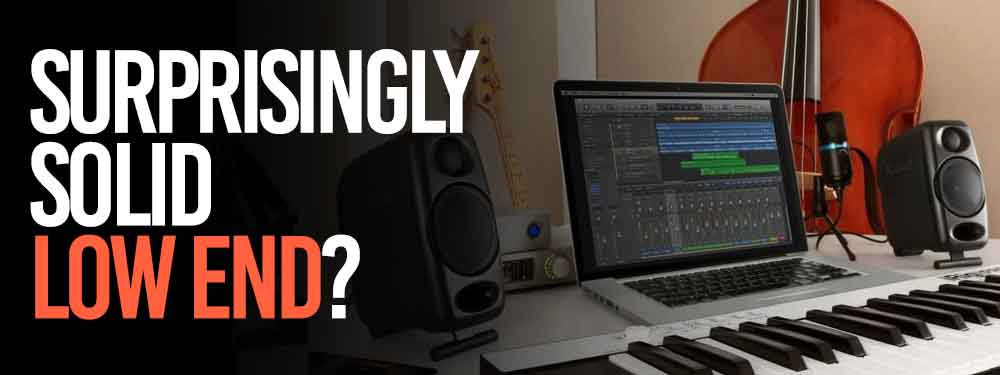
The iLoud Micro Monitors is a compact monitor that features a dual-purpose design, which sets it apart from other monitors in the market.
The monitor has a built-in amplifier, and it produces strong low frequencies.
Additionally, the monitor has a built-in phone and audio cable, which makes it easy to switch between devices. The iLoud Micro Monitor offers crystal-clear sound waves thanks to its active noise-canceling technology.
The monitor also features a built-in LED light, which is convenient for indoor and outdoor use.
The iLoud Micro Monitor is extremely portable, making it an excellent choice for musicians, DJs, public speakers, and more.
For a small studio with no acoustic room treatment, this monitor is perfect.
For those who are always on the go and need to get projects done in unpredictable situations - which includes studios that lack proper acoustic treatments is one of the best portable monitors available for purchase!
Check out the iLoud Micro Monitors here.
#8. JBL Professional 1 Series, 104 Compact Reference Monitors
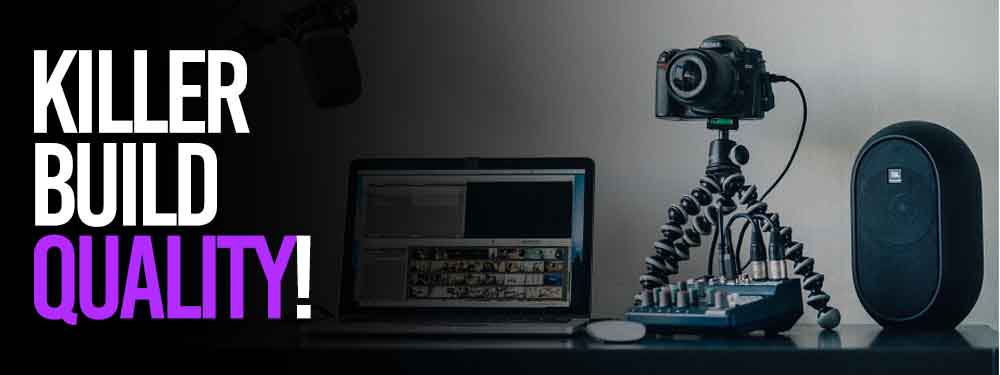
These speakers have 60 W of class D power, and 4.5" dual-concentric drivers to provide sound that is perfect for desk placement.
With three input ports and the acoustic adjustment for desktop use, you can connect various devices with these monitors from JBL.
This set of monitor speakers will not only work great as a full-size speaker but it also has an advantage in small areas where larger-sized ones just won't fit!
They deliver warm sounds and crisp vocals, making them great for listening to your favorite tunes.
The speakers are made with a wood fiber woofer and silk dome tweeter. The materials produce a warm and detailed sound.
They also feature a built-in amplifier to power the speakers, which makes them easy to use.
Check out the compact JBL Professional 1 Series here.
#7. Behringer MS16 Powered Studio Desktop Monitors
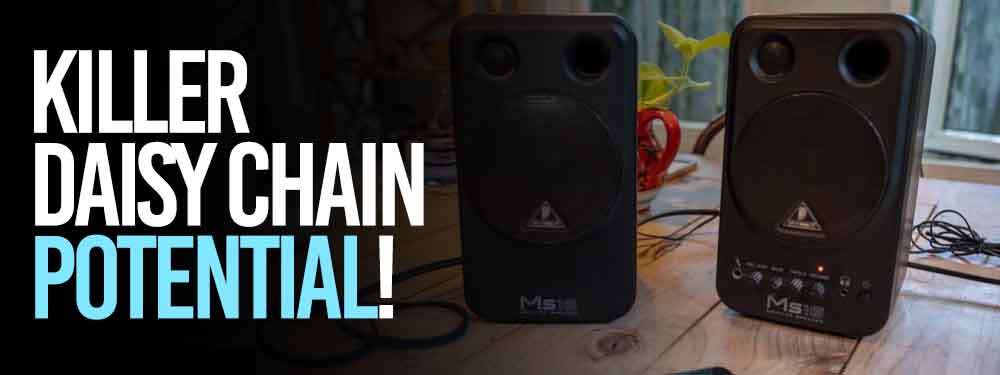
The Behringer MS16 Powered Studio Desktop Monitors set is another affordable desktop monitor set that is very suitable for multimedia in conjunction with vocal and music monitoring applications.
It comes at 7.7 lbs in size, 5.9" x 5.5" x 9.4".
Utilizing the 4" woofer and high-resolution tweeter equipped with two 8-watt amplifiers, this setup produces an accurate sound output for you to use for voice or music listening purposes: a time-tested product!
The Behringer MS16s are semi-active, ported speakers with a 16-ohm impedance, so they’re best paired with a lower-powered amp or recording interface.
You can also daisy-chain these monitors with other Behringer products to increase the overall volume.
The Behringer MS16s have a nice, balanced sound with a slight emphasis on mids.
They are also very versatile, with controls for treble, bass, and volume.
The large front panel also includes a headphone jack for private monitoring.
The Behringer MS16s is a good option if you want a dependable pair of affordable monitors.
Check out the Behringer MS16 monitors here.
#6. Alesis M1 Active 320 USB
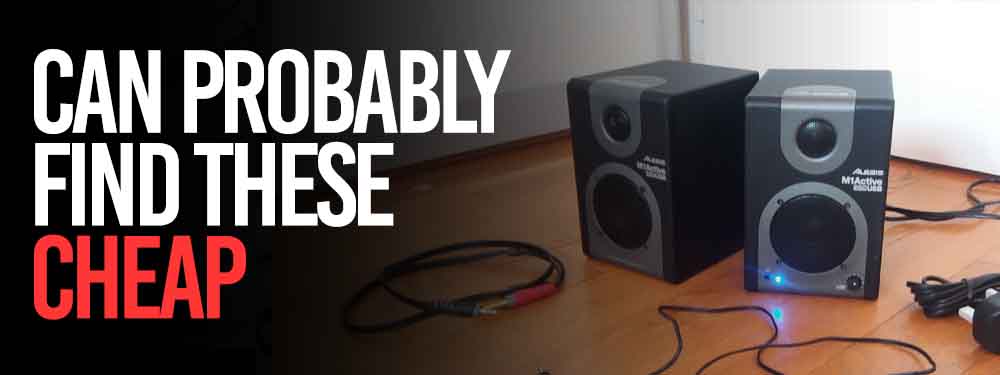
The Alesis M1 Active 320 USB is a stereo monitor with an audio interface.
It has a one-inch tweeter and a 3-inch woofer, operating at 16-bit/44.1 - 48kHz recording and playback.
They feature 1/8 inch (3.5mm), RCA input as well as 1/4 inch inputs that can be switched to the power supply on the monitors themselves or through a switch in front of the speakers.
These monitors also produce fully rich acoustics characterized by frequency response up to 20 kHz.
This studio monitor speaker is small enough to fit in most rooms, and the response curve is tailored for small rooms, helping you engineer your mixes and recordings with accurate frequency responses.
With its dedicated volume control, you can adjust the level to your liking, and an LED indicator lets you know when the M1 Active is powered on.
The M1 Active features a ported cabinet design, providing a deep, rich bass response.
The silk dome tweeters deliver crisp, clear high frequencies.
The magnetic shielding prevents interference with computer monitors and other electronic equipment.
With the M1 Active, you can mix, record, and monitor with ease thanks to its convenient controls.
Check out the Alesis M1 Active 320 USB monitors here.
#5. Genelec 8010A PM
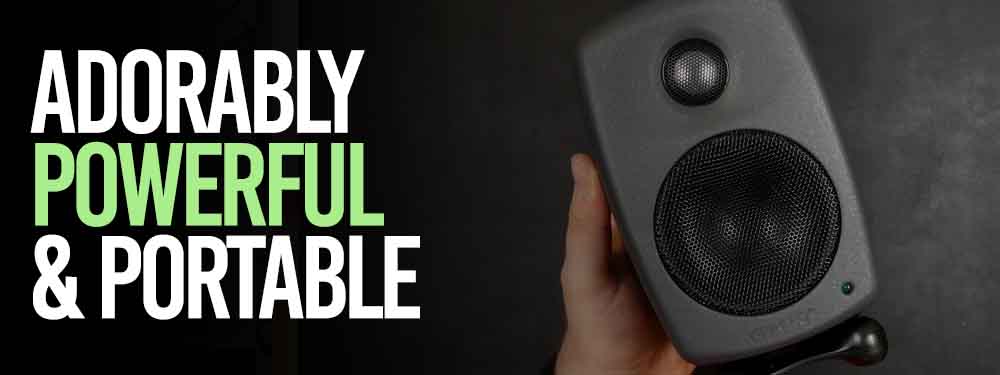
The Genelec 8010A Studio Monitor is another professional and high-end portable studio monitor that has Bluetooth capability.
It only weighs 3.3 pounds and is one of the best lightweight, portable monitors you can carry around with you wherever you go!
The 8010A is a small diaphragm active studio monitor with a very light and compact design intended for small rooms and home studios.
The 8010A is an active monitor, which means that it has its own amplifier and does not require external amplification.
The 8010A has a built-in limiter and its own equalizer with settings for low, mid, and high-frequency bands.
Additionally, it has a -6 dB switch to accommodate very low-volume monitoring situations.
The 8010A features a cardioid pattern to reject sound from the side and front to provide better isolation for the intended source.
It has a frequency response of 45 Hz - 20 kHz.
The 8010A has a single XLR input with a -10 dB pad, as well as RCA inputs for non-XLR sources with a -18 dB attenuation. It also has a volume control knob on the front panel.
Check out the Genelec 8010A PM monitors here!
#4. Samson M30
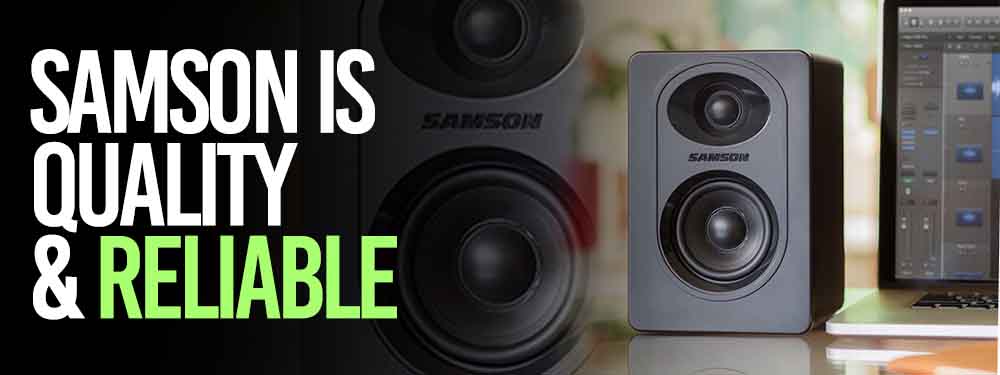
A great choice for beginners, Samson's M30s is a small studio monitor that is perfect for starting your own home studio.
They're not too big and will fit on your desk comfortably in a small room.
The frequency response is 50Hz-20kHz, which sounds good considering the size of this speaker system.
I recommend these speakers if you need something to mix while working in small spaces like bedrooms or offices.
They provide balanced sound with bass boost, but you can always add more low-end by plugging into an AUX out port (it also works without subwoofers).
If space isn't an issue, or if more power is necessary, we recommend stepping up from these to something like Samson’s M50s which output 40W per channel but are slightly bigger in size than these.
The M30s deliver crisp highs, a wide frequency response (50 Hz– 20 kHz), and detailed imaging.
The passive heat sink keeps the monitors cool during extended use.
The M30s have a ported enclosure that delivers deep and rich bass. The monitors are magnetically shielded to prevent interference with other devices.
Check out the Samson M30 monitors here!
#3. Mackie CR-X 5
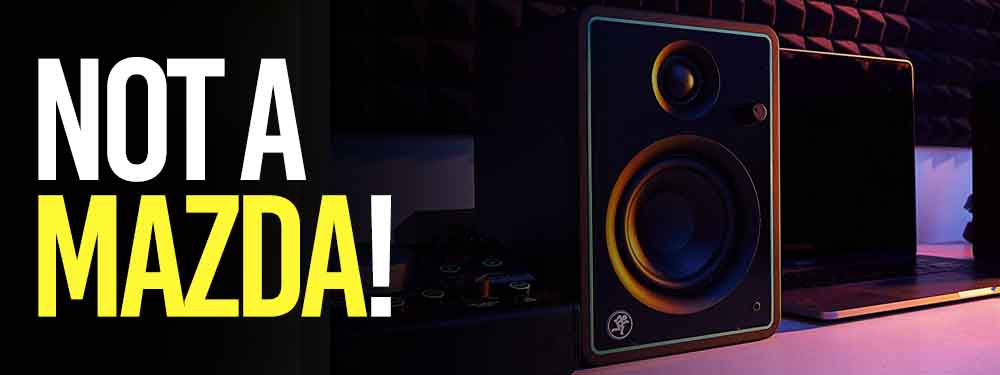
The speakers have an 80W amplifier and they don't specify their frequency range (Mackie always keeps it under wraps).
When it comes to high-end studio monitors, Mackie is near the top of the list.
Each speaker has a 5-inch woofer and a .75-inch tweeter, which is what you should expect from speakers in this size class.
The CRX5s come with a pair of TRS (1/4-inch) inputs, RCA inputs, as well as an AUX input.
This generous assortment allows you to keep your studio monitors connected to different sources simultaneously without having to constantly plug or unplug cables!
One downside that can be seen on the CRX5s is their weight; at around 15 pounds these will not be portable for long periods of time!
It's definitely not one of the smaller monitors on this list and by no means one of the bookshelf speakers.
If the size isn’t a big issue, Mackie’s CR-X 5s are sure to deliver crystal clear sound that’ll help make it easier for you to get the perfect mix.
Check out the Mackie CR-X 5 monitors here.
#2. Yamaha HS5 Powered Studio Monitor
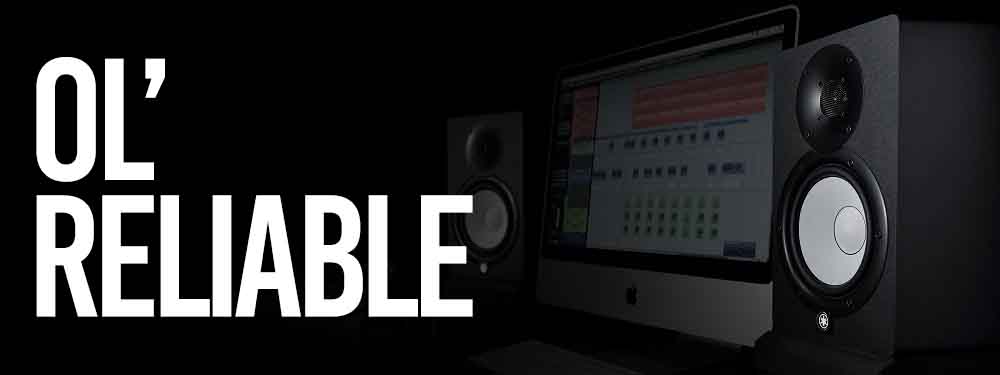
The HS5 model is designed to provide accurate monitoring in small rooms and is ideal for home studios.
It has a high maximum volume to compensate for the lack of acoustic treatment and low walls.
The HS5 has a 5” driver with a carbon fiber composite frame that delivers deep lows, smooth mids, and crisp highs.
The HS5's pivoting bass port lets you angle the speaker to compensate for room acoustics, and the included wall mount bracket lets you mount the HS5 on the wall to save space.
The HS5 has a single XLR input for connection to audio sources, and the rear panel has a volume control.
Weighing 12 pounds and measuring 7 x 9 x 12 inches, it’s not exactly a portable kind of monitor you can comfortably carry around with you.
However, if the size isn’t an issue for your studio set up then this could be a great quality studio monitor that will fit anywhere in your home or bedroom studio!
The sweet spot is the low frequencies - you'll get a smooth response in both the low and mid-range.
This 2-way bass-reflex bi-amplified nearfield studio monitor utilizes both a 5-inch cone woofer and a 1-inch dome tweeter which enables it to handle a frequency response range of 54 Hz – 30 kHz respectively, as well as includes a low-frequency extension. You also get a room control switch.
Furthermore packed with several advanced features such as a low resonance enclosure design (prevents sound from bouncing back into the cabinet.)
Room control & high TRIM response controls (enables adjustments when listening on different surfaces), advanced noise reduction technology, latest transducers, and more.
Check out the Yamaha HS5 Powered Studio Monitor here.
#1. KRK ROKIT 5 G4
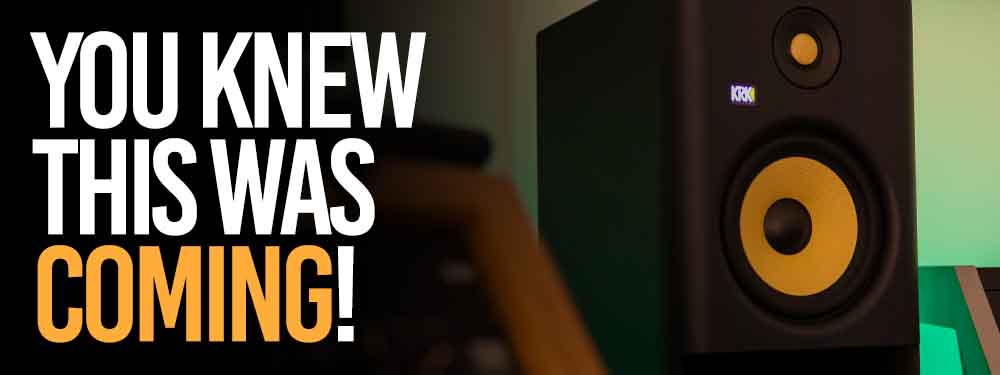
The KRK Rokit G4 (Generation 4) is the most advanced speaker system from KRK that caters to professional studio-grade monitoring applications.
Unlike Generation 3 models, which are geared more towards casual listening and monitors, these speakers produce heavy-mix bass sounds.
The low-end response is great thanks to the redesigned bass reflex port and low-distortion Kevlar drivers.
You can also tone down the bass if you want to; however, mid-frequencies seem less powerful than what we find in JBLs.
The mid-frequency sounds are still fine and the overall frequency balance is among the best.
The speakers feature EQ switches and an LCD visual EQ on the back of each monitor, a big upgrade from the G3 model.
As for the weightiness of these speakers: they’re heavier than those made by JBL— so carrying them around won't work if portability matters for you!
The proprietary waveguide technology used in this model is optimized for better stereo sound - making it a good option for smaller spaces like music producers' studios or apartments.
Overall, when you're looking for audio equipment that can rival recording studio quality, the KRK Rokit 5 G4s are among the best studio monitors you can find.
Check out the KRK ROKIT 5 G4 monitors here.
Studio Monitor Positioning and Placement for Limited Space
If you have a smaller studio, you might not have enough space to have a full-size studio monitor on each side of your desk.
In this case, you have a couple of options.
Positioning your speaker properly is a form of room correction to help your monitors sound awesome.

You can put one smaller studio monitor on each side, or you can put them all on one side.
If you put them all on one side, there are a couple of things to keep in mind.
You want to make sure that the position of the monitors is staggered.
You want to make sure that your ear is not lined up with the same side of the monitors.
In all cases, you want to make sure that your ear is at least 2 feet away from the monitor.
Here's a video tutorial on proper studio monitor positioning:
How to Maximize Sound Quality in a Small Room
One of the biggest issues that people run into when trying to set up a small home studio is that their room isn’t acoustically ideal.
The good news is that there are a few things you can do to improve the sound quality of your recordings, even if your room isn’t perfect.
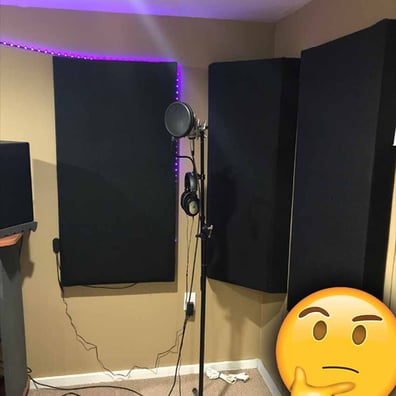
You’ll want to do your best to block any loud sources of noise.
Things like air conditioning units, large windows, or high-traffic areas can cause major interference if they’re too close to your mic.
And lastly, you can make your room more acoustically ideal by adding sound-dampening materials.
There are a lot of options out there, from acoustic panels to fabrics, and they all have different benefits.
How to Get a Flat Frequency Response In a Small Room
To get a flat frequency response in a small room, you can use many techniques:
- Acoustic panels
- Bass traps
- Sound diffusers
These all achieve the right reverb time.
Acoustic panels are best for treating mid to high-frequency range, while bass traps are good at reducing low-frequency range.
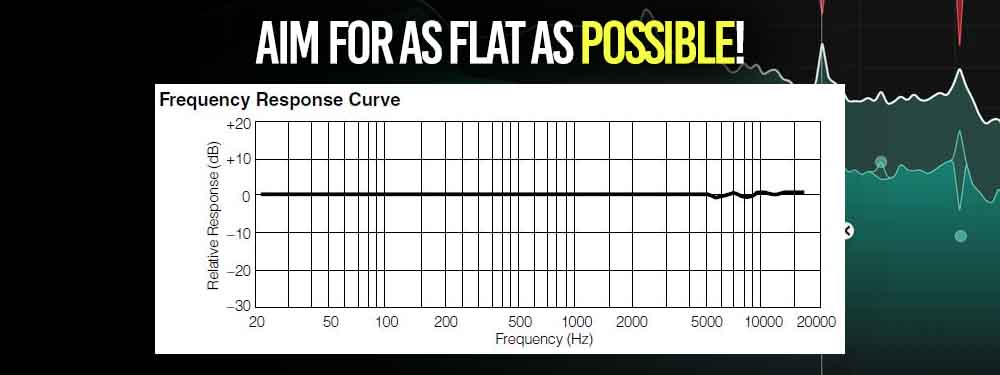
Sound diffusers work great at softening the sound of a room and reducing the reverb time.
Depending on the shape of your room and desired acoustic treatment, you can choose from a variety of panels and diffusers.
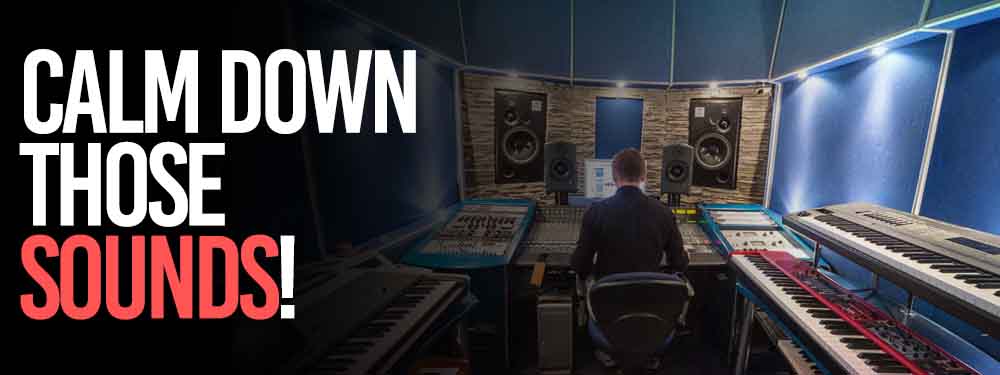
These range from fabric to wood, offering a variety of looks to match any decor.
Picking The Best Speaker Size
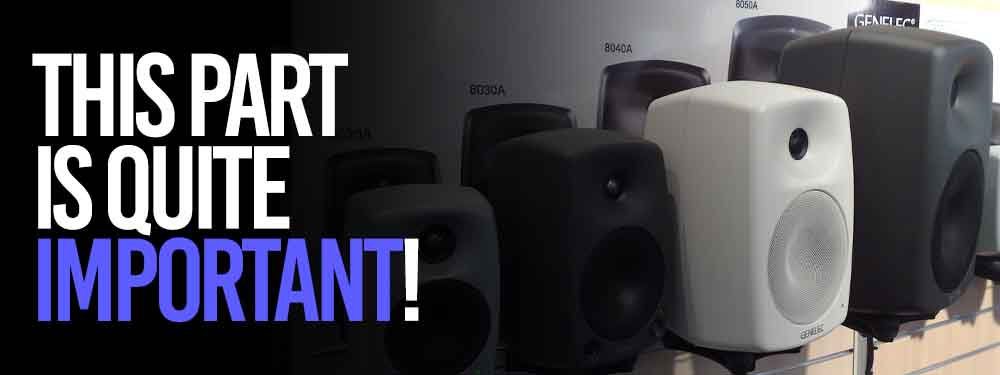
When choosing the right size for your small room, you want to make sure that your monitors are large enough to create the best audio possible without being too large to fit in your space.
The best way to determine the right size for your studio monitors is to start with their recommended driver size.
The driver is the part of the speaker that produces sound, and each manufacturer has their own recommended driver size.
If you are purchasing new monitors, make sure to check their driver size.
If you are upgrading from existing speakers, you can still find the driver size on most speakers.
Most drivers range from 5 to 10 inches, with some being as small as 3 inches.
Small studio monitors will usually come with 3-5 inch driver tops.
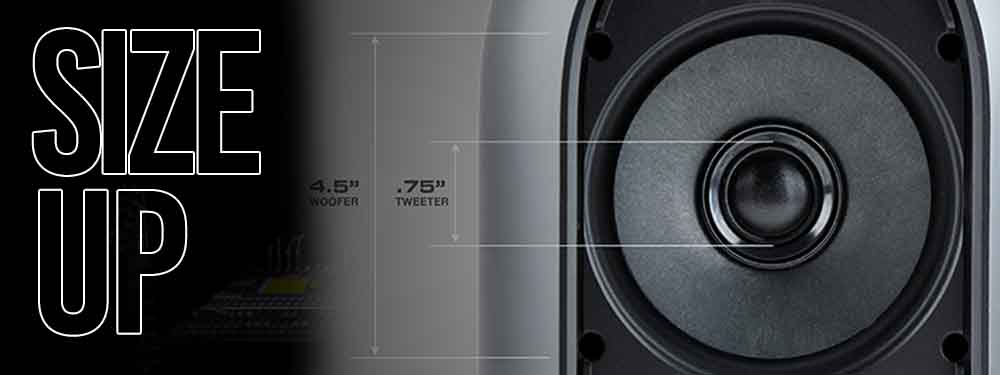
The smaller the drivers, the weaker the low frequencies in most cases.
The key is to find the sweet spot where you can hear as many sound frequencies as possible in your small room.
Once you have determined the best driver size for your space, you can then choose the best size for your monitors.
Picking Small Studio Monitors With a Good Frequency Range
When choosing a pair of small studio monitors, one of the most important things to look for is the frequency range.
The majority of monitors will fall between 80 Hz and 20 kHz, which is the audible range for the human ear. However, some monitors can go as low as 40 Hz, and others can go as high as 30 kHz.

The lower the frequency range, the deeper the bass.
The higher the frequency range, the higher the treble. Depending on what you are recording, one may be more important than the other.
If you are recording acoustic instruments, such as a piano or acoustic guitar, you will want to make sure that the monitors you are using have a very high-frequency range to accurately reproduce the sound of those instruments.
You’ll also want studio monitors with a low latency, which is the delay between when a sound is produced and when it’s reproduced.
Most studio monitors hover around the 10–20 millisecond range, which is fine for most people. Avoid monitors that have a high distortion rate, as this will cause them to produce unnatural-sounding audio.
Lastly, you’ll want monitors with a wide dynamic range, which is the difference between the loudest and softest sound they can produce.
Why Frequency Response Matters
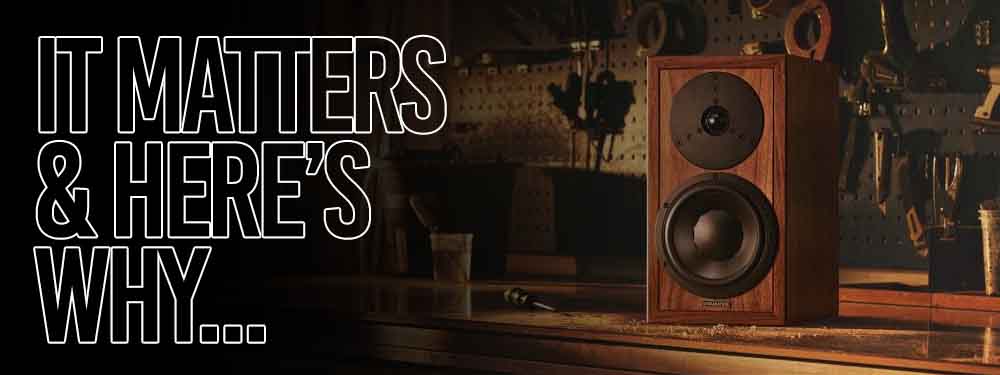
The frequency response of a speaker is the range of sound that it can produce, from the lowest to the highest notes.
A speaker with excellent frequency response will be able to reproduce all notes within that range without any loss of quality.
The human ear can hear sounds within a range between 20 Hz and 20,000 Hz, but most people can only hear up to 16,000 Hz.
Despite this, speakers with good frequency responses can provide a much better audio experience to those who need it.
A speaker with poor frequency response will struggle to reproduce certain notes within the audible range of the human ear, resulting in a reduction in audio quality that many people will struggle to notice.
Poor frequency response can also lead to issues with speaker distortion.
A speaker with a low-frequency response will struggle to produce notes at the low end of the audible range.
This will often result in a significant amount of distortion, reducing the quality of the audio even further.
Picking Compact studio monitors for small studio Spaces
If you’re working in a small studio, you’re probably going to want to go with something compact.
There are many good choices for the best small studio monitors out there.
If you have limited space, it’s going to be difficult to set up large studio monitors.
In these situations, it’s best to go with a bookshelf model.
Most of the best bookshelf monitors are compact, so it’s a good bet if you need something small.
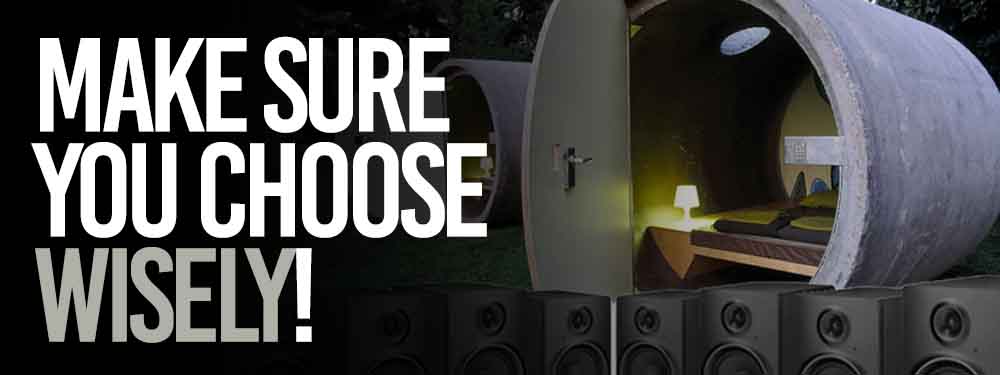
It’s also a good idea to go with active monitors if you’re working in a small studio.
Active monitors have their own power supply, so you won’t have to deal with long power cords.
This is important for small studios, where every inch of space counts. Some monitors will also include a low-frequency port.
Monitor placement is an important detail that can affect the overall sound quality in your studio.
Placing your monitors too close can cause a “clipping” noise in your recordings.
Ideally, you want to place your monitors about 3–6 feet from your recording position.
Difference Between Studio Monitors vs. Speakers
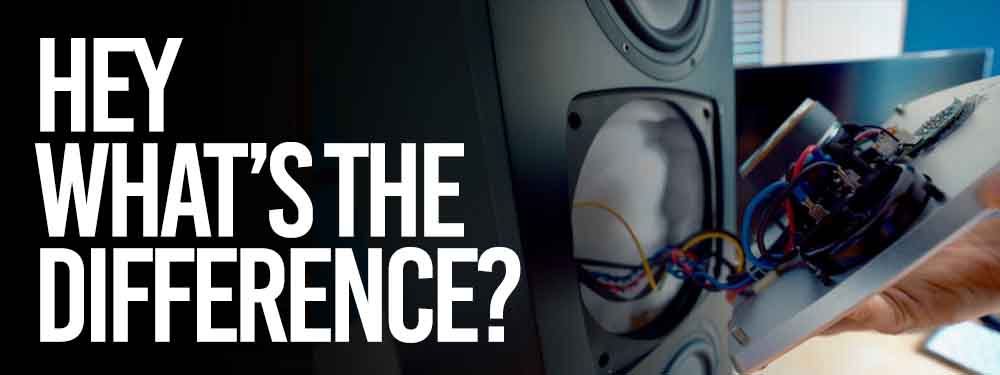
There are some significant differences between these two types, and knowledge will help you pick the best studio monitors for a small room.
Studio monitors are specifically designed for audio production, recording, and mixing.
These speakers have increased power handling, accurate response, and high-fidelity sound for hearing every detail during the creative process.
On the other end of the spectrum, computer speakers are designed for casual listening to music and watching videos.
They have a high power output for filling the room with sound.
The sound quality is not as accurate or detailed as studio monitors, but they are designed to enhance the overall experience.
These two types of speakers have some major differences.
But even small monitors can sound better than big speakers in terms of quality.
The best choice for you will depend on your specific needs.
Hopefully, this comparison has provided you with the information you need to make the right decision.
Get your music on playlists now.
It’s time you get your exposure and listeners up - playlisting by Boost Collective has been trusted by 50,000+ artists worldwide.
It’s easy: Search your song, get on playlists, and track your campaign.
What’re you waiting for? Tap in - and get added to playlists in 24 hours.


